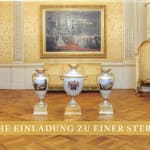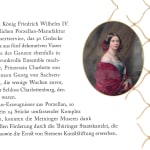K.P.M. Königliche Porzellan-Manufaktur, Berlin
Further images
-
(View a larger image of thumbnail 1
)

-
(View a larger image of thumbnail 2
)

-
(View a larger image of thumbnail 3
)

-
(View a larger image of thumbnail 4
)

-
(View a larger image of thumbnail 5
)

-
(View a larger image of thumbnail 6
)

-
(View a larger image of thumbnail 7
)

-
(View a larger image of thumbnail 8
)

-
(View a larger image of thumbnail 9
)

Provenance
Commissioned by Frederick Wilhelm IV King of Prussia on 6thNovember 1850 and given by him as a gift to Georg II, Crown Prince of Saxe-Meiningen upon his marriage to Princess Charlotte Frederica of Prussia.
By tradition displayed at Schloss Sanssouci. Adolph Labrenz, Berlin. Acquired by the Feist Family, Berlin. Mr. and Mrs. William Wagner, Berlin and United States.
A highly important and very beautiful Classical gilt and polychrome painted porcelain armorial and topographical three-piece vase garniture from “The Meiningen Service” made by the Royal Berlin Porcelain Manufactory (K.P.M) and commissioned in 1850 by Frederick Wilhelm IV King of Prussia as a wedding gift to Georg II, Crown Prince of Saxe-Meiningenand Princess Charlotte Frederica of Prussia. The models by the renowned architect and designer Karl Friedrich Schinkel and boasting extremely finely painted architectural views after works by Carl Daniel Freydanck, bearing various blue monogram and sceptre marks, iron-red no. 3 or no. 4, with a gilt cross on each of the side vases and a green asterisk to the central vase with additional incised and impressed numerals on the stands including the letters E F in black script on the central stand. The garniture comprised of a central amphora ‘Münchner’ vase, Sorte 3, with gilt painted handles and finely painted on the front with a battle scene depicting Renaissance warriors defending a bridge from attack and on the obverse with the State coat-of-arms for the Archdukes and Dukes of Saxe-Meiningen (Staatswappen der Erzherzöge und Herzöge von Sachsen-Meiningen), the heraldic bearing for the coat-of-arms resting on an ermine-lined mantel respecting listing from left to right and top to bottom as follows
1: Landgrafschaft Thüringen; 2: Herzogtum Cleve; 3: Markgrafschaft Meissen; 4: Herzogtum Jülich; 5 A & B: Grafschaft Landsberg; 6: Herzogtum Berg; 7: Pfalz-Sachsen; 8: Grafschaft Orlamünde; 9: Pfalz-Thüringen; 10: Herrschaft Eisenberg; 11: Herrschaft Pleissen; 12: Burggrafschaft Altenburg; 13: Ein lediges rotes Feld wegen der Regalien/Steuern auf die nur der König Anspruch hatte; 14: Grafschaft Brena; 15-17: Herrschaft Römhild und Gefurstete/Grafschaft Heneberg sovereign country; 18: Grafschaft Ravensberg and the six helms as follows 1: Herzogtum Sachsen; 2: Landgrafschaft Thüringen; 3: Gefrstete Grafschaft Heneberg; 4: Markgrafschaft Meissen; 5: Herzogtum Jülich; 6: Herzogtum Berg. The central vase flanked by a pair of ‘Veduten-Maler’ baluster vases, each with tall gilt painted scroll and rosette handles, each finely painted with architectural studies after Carl Daniel Freydanck with the locations identified by various inscriptions on the interior of each rim, one with a view of the terraced gardens at Sanssouci Palace, inscribed Schlofs Sans=souci, the obverse with a view of Schloss Babelsberg, inscribed Schlofs Babertsberg [sic]; the other with a view of the Prince Albrecht Palace , inscribed Palais des Prinzen. Albrecht and the obverse with The Long Bridge before the King’s Palace in Berlin, inscribed Das Schloss u.d. Lange Brücke. All three vases with a banded gilt surround reserved on a finely gilt lattice-work ground, the neck and spreading foot banded with a floral border of tight bouquets, rocaille-scroll gilt trellis and shells, supported on gilt enriched stepped square bases, the tops chased with vermiculé
Berlin, commissioned in 1850
Height of the central vase: 91.5 cm, height of the two flanking vases: 81 cm.
This outstanding and very impressive three-piece royal garniture by the Royal Berlin Porcelain Manufactory or the Konigliche-Porzellan-Manufaktur (K.P.M) was commissioned by Frederick Wilhelm IV King of Prussia on the 6thNovember 1850 and given to his close military confidant Georg II, Crown Prince of Saxe-Meiningen (1826-1914) upon his marriage to the King’s highly eligible and attractive niece Princess Charlotte Frederica (1831-55). A detailed ledger housed at the Berlin K.P.M. Archive (housed at Schloss Charlottenburg) records the present multi-vase garniture and its matching dessert service for fifty people (see: Pret II, Contobuch Sr. Maj. des Königs 1818-1850, p. 172-175). The King’s registry for that date notes that it was intended for “For SR: Highness the ERB Prince of Saxony: Meiningen”. The entry listing the topographical views and other corresponding details, which match exactly, also includes the cost of production.
Georg II, Crown-Prince of Saxe-Meiningen fought alongside the Prussian forces during the Franco-Prussian War and is noted for leading two regiments of soldiers from Meiningen to victory at the Battle of Froeschweiler. It is almost certain that the battle scene showing Renaissance warriors defending a bridge on the central vase is an allegorical reference to this event. The reference to the Crown-Prince is further reinforced on the obverse of the vase which is painted with the State coat-of-arms and heraldic bearings for the Archdukes and Dukes of Saxe-Meiningen. Georg II and his much loved wife Charlotte lived in Berlin and Potsdam after their marriage before returning to Meiningen for the birth of their children. Sadly their happiness and marriage was cut short in 1855, when a few months after the death of their two year old son Georg Albrecht, Charlotte and their fourth child died during childbirth. Georg was left distraught but nevertheless three years later remarried Princess Feodora Victoria Adelaide (Queen Victoria’s niece) by whom he had four more children but unlike his first marriage, the second was not a happy one. Reflecting better days during his first newlywed period, the flanking vases are finely decorated on both sides with topographical views including: Schloss Sanssouci and Schloss Babelsberg, The Prince’s Palace Albrecht and a view of the Long Bridge before the King’s Palace in Berlin.
The models for the vases were designed by Karl Friedrich Schinkel (1781-1841). Best known as one of the leading Prussian architects and city planners, he also worked as a painter, designer of furniture, stage sets and porcelain and in that respect often worked closely together with the Berlin Porcelain Manufactory. Like Percier and Fontaine in Paris, Schinkel set the stylistic tone in Prussia.
Each of the detailed topographical views is derived from paintings by Carl Daniel Freydanck (1811-87), one of the finest landscape painters of his day whose work was reproduced by the Berlin factory. His topographical oils included numerous scenes of royal residences. In this instance the view portraying the Palace of Sanssouci was derived from one of Freydanck’s paintings of 1843, housed at the K.P.M. archive, (inv. no. 173). Among other of his topographical oils used by K.P.M. was an elongated “Panoramic View of Potsdam as seen from the terrace at Sanssouci” (illustrated in “Along the Royal Road, Berlin and Potsdam in KPM Porcelain and Painting 1815-1848”, ed. by Derek E. Ostergard, circa 1993, pp. 196-7). Sanssouci, the lavish pavilion and country residence of Frederick the Great was built by the architect Georg von Knobeldorff between 1745 and 1747. The terraced gardens below, commanding superb views over Potsdam, were originally finely manicured and planted with fruit but by the nineteenth century they had fallen into disrepair and become overgrown. On the King’s instigation the palace grounds were extended and remodelled as part of a larger vision for the Potsdam area by Peter Joseph Lenné (1789-1866). In 1836, the cast-iron bridge, seen in the foreground, spanning the Schafgraben (Sheep Canal) was built by none less that Karl Friedrich Schinkel (with whom Lenné frequently collaborated) to replace an earlier and less ornate structure. Beyond the bridge can be seen the great fountain; in 1842, two years after ascending the throne, Frederick Wilhelm IV, improved its water pressure by installing a steam engine which pumped water up the Ruinenberg to a reservoir. Prior to that, the great fountain was rarely in use owing to insufficient water pressure. The basin of the fountain was also replaced by a larger one, and by 1848 the surrounding sculptures and stone benches resembled the configuration illustrated on the present vase.
On the other side of the same flanking vase is a view of Schloss Babelsberg, an English Gothic style summer palace in Potsdam, which was commission by Prince William (Frederick Wilhelm IV’s eldest brother), and his wife, Augusta, Princess of Sachsen-Weimar. During the years 1835-1849, the architectural plans proposed by Karl Friedrich Schinkel, Ludwig Persius and Princess Augusta were modified and then completed after Schinkel’s death by Johann Heinrich Strack. Among other rare K.P.M. pieces portraying the same view of Babelsberg is a porcelain tray from a Royal presentation travel service, (see “Along the Royal Road, Berlin and Potsdam in KPM Porcelain and Painting 1815-1848”, 1993, p. 174), while a ‘Veduten-Maler’ amphora vase with griffin handles, portraying the same view was sold by Christie’s, New York, 18thOctober 2002, lot 461.
The front of the corresponding vase features a view of the Palais Prinz Albrecht in Berlin. This Rococo residence, originally built in 1737-1739, was in 1830 acquired by King Frederick William IV’s youngest brother Prince Albert and his wife Princess Marianna of the Netherlands (Princess Charlotte’s parents). In his desire to remodel the palace as his main residence, Prince Albert also commissioned the architectural team Schinkel and Lenné. The surrounding grounds, designed by Lenné, included a riding stable and an ice rink which was open to the public.
On the obverse of the Palais Prinz Albrecht is a view of the Königliche Schloss and the Lange Brücke or the Long Bridge in front of the King’s palace in Berlin. The bridge, built after designs by Johann Arnold Nering upon the foundations of an earlier structure was opened in 1703 and featured an equestrian figure of the Electoral Prince Frederick I at centre. During the mid nineteenth century Schinkel designed elaborate cast-iron railings for the bridge which incorporated seahorses, dolphins and tritons as well as additional sculptural elements to the overall design (see Ilse and Winfried Baer et al., “Carl Daniel Freydanck 1811-1887 Ein Veduten-Maler der KPM”, Schloss Charlottenburg Exhibition Catalogue, 6thJune – 30thAugust 1987, p. 87, cat. 8, inv. no. 45, for a detailed study of the Lange Brücke).
The first Berlin Porcelain factory, founded by Wilhelm Kaspar Wegely in 1752, produced good, slightly opaque, hard paste porcelain table decorations, impressive vases and statuettes but after five years it was forced to close. In 1761 a financier named Johann Ernst Gotzkowsky founded a second factory but after it ran into financial difficulties, the concern was acquired by Frederick the Great (1712-86) in 1763. Thus the enterprise became a royal factory and remained so up until 1918 when it became state property and still continues today as a flourishing concern. During the eighteenth century K.P.M. produced some outstanding pieces of a creamy tone, modelled and painted with great delicacy in a restrained Rococo manner. The adoption of a different type of kaolin soon after 1770 led to a much whiter coloured porcelain, which also coincided with a more severe but simplified style of modelling in the Neo-classical fashion. The classicising influenced became increasing evident under the patronage of Friedrich Wilhelm II and continued to do so during the nineteenth century when his son Friedrich Wilhelm III and grandson Friedrich Wilhelm IV were on the throne.








